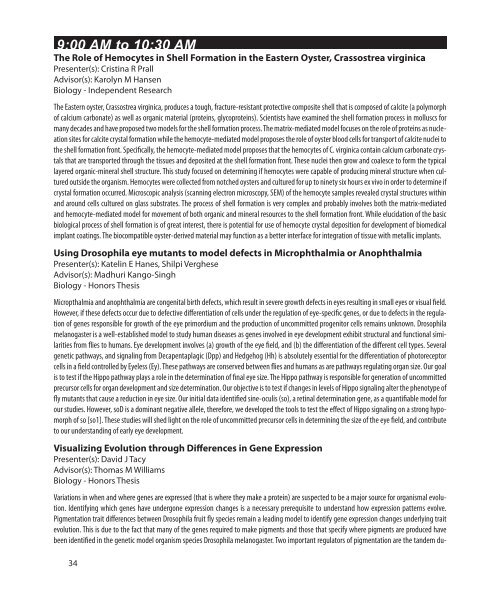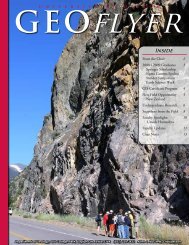Stander Symposium abstract book - University of Dayton
Stander Symposium abstract book - University of Dayton
Stander Symposium abstract book - University of Dayton
You also want an ePaper? Increase the reach of your titles
YUMPU automatically turns print PDFs into web optimized ePapers that Google loves.
9:00 AM to 10:30 AM<br />
The Role <strong>of</strong> Hemocytes in Shell Formation in the Eastern Oyster, Crassostrea virginica<br />
Presenter(s): Cristina R Prall<br />
Advisor(s): Karolyn M Hansen<br />
Biology - Independent Research<br />
The Eastern oyster, Crassostrea virginica, produces a tough, fracture-resistant protective composite shell that is composed <strong>of</strong> calcite (a polymorph<br />
<strong>of</strong> calcium carbonate) as well as organic material (proteins, glycoproteins). Scientists have examined the shell formation process in molluscs for<br />
many decades and have proposed two models for the shell formation process. The matrix-mediated model focuses on the role <strong>of</strong> proteins as nucleation<br />
sites for calcite crystal formation while the hemocyte-mediated model proposes the role <strong>of</strong> oyster blood cells for transport <strong>of</strong> calcite nuclei to<br />
the shell formation front. Specifically, the hemocyte-mediated model proposes that the hemocytes <strong>of</strong> C. virginica contain calcium carbonate crystals<br />
that are transported through the tissues and deposited at the shell formation front. These nuclei then grow and coalesce to form the typical<br />
layered organic-mineral shell structure. This study focused on determining if hemocytes were capable <strong>of</strong> producing mineral structure when cultured<br />
outside the organism. Hemocytes were collected from notched oysters and cultured for up to ninety six hours ex vivo in order to determine if<br />
crystal formation occurred. Microscopic analysis (scanning electron microscopy, SEM) <strong>of</strong> the hemocyte samples revealed crystal structures within<br />
and around cells cultured on glass substrates. The process <strong>of</strong> shell formation is very complex and probably involves both the matrix-mediated<br />
and hemocyte-mediated model for movement <strong>of</strong> both organic and mineral resources to the shell formation front. While elucidation <strong>of</strong> the basic<br />
biological process <strong>of</strong> shell formation is <strong>of</strong> great interest, there is potential for use <strong>of</strong> hemocyte crystal deposition for development <strong>of</strong> biomedical<br />
implant coatings. The biocompatible oyster-derived material may function as a better interface for integration <strong>of</strong> tissue with metallic implants.<br />
Using Drosophila eye mutants to model defects in Microphthalmia or Anophthalmia<br />
Presenter(s): Katelin E Hanes, Shilpi Verghese<br />
Advisor(s): Madhuri Kango-Singh<br />
Biology - Honors Thesis<br />
Micropthalmia and anophthalmia are congenital birth defects, which result in severe growth defects in eyes resulting in small eyes or visual field.<br />
However, if these defects occur due to defective differentiation <strong>of</strong> cells under the regulation <strong>of</strong> eye-specific genes, or due to defects in the regulation<br />
<strong>of</strong> genes responsible for growth <strong>of</strong> the eye primordium and the production <strong>of</strong> uncommitted progenitor cells remains unknown. Drosophila<br />
melanogaster is a well-established model to study human diseases as genes involved in eye development exhibit structural and functional similarities<br />
from flies to humans. Eye development involves (a) growth <strong>of</strong> the eye field, and (b) the differentiation <strong>of</strong> the different cell types. Several<br />
genetic pathways, and signaling from Decapentaplagic (Dpp) and Hedgehog (Hh) is absolutely essential for the differentiation <strong>of</strong> photoreceptor<br />
cells in a field controlled by Eyeless (Ey). These pathways are conserved between flies and humans as are pathways regulating organ size. Our goal<br />
is to test if the Hippo pathway plays a role in the determination <strong>of</strong> final eye size. The Hippo pathway is responsible for generation <strong>of</strong> uncommitted<br />
precursor cells for organ development and size determination. Our objective is to test if changes in levels <strong>of</strong> Hippo signaling alter the phenotype <strong>of</strong><br />
fly mutants that cause a reduction in eye size. Our initial data identified sine-oculis (so), a retinal determination gene, as a quantifiable model for<br />
our studies. However, soD is a dominant negative allele, therefore, we developed the tools to test the effect <strong>of</strong> Hippo signaling on a strong hypomorph<br />
<strong>of</strong> so [so1]. These studies will shed light on the role <strong>of</strong> uncommitted precursor cells in determining the size <strong>of</strong> the eye field, and contribute<br />
to our understanding <strong>of</strong> early eye development.<br />
Visualizing Evolution through Differences in Gene Expression<br />
Presenter(s): David J Tacy<br />
Advisor(s): Thomas M Williams<br />
Biology - Honors Thesis<br />
Variations in when and where genes are expressed (that is where they make a protein) are suspected to be a major source for organismal evolution.<br />
Identifying which genes have undergone expression changes is a necessary prerequisite to understand how expression patterns evolve.<br />
Pigmentation trait differences between Drosophila fruit fly species remain a leading model to identify gene expression changes underlying trait<br />
evolution. This is due to the fact that many <strong>of</strong> the genes required to make pigments and those that specify where pigments are produced have<br />
been identified in the genetic model organism species Drosophila melanogaster. Two important regulators <strong>of</strong> pigmentation are the tandem du-<br />
34

















